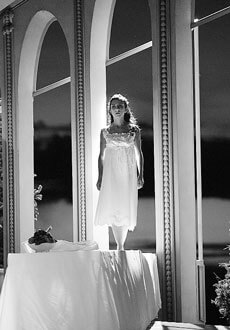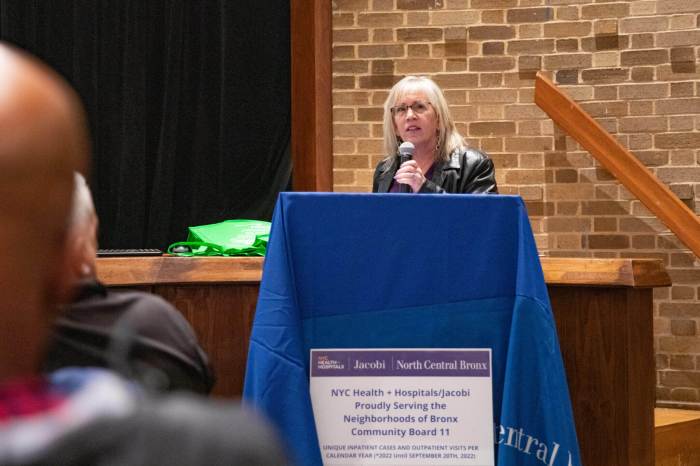Agrippina’ the highlight of the final shows of Santa Fe’s festival
Santa Fe Opera’s open-sided home in its stunning mountain setting makes for great theater even before the opera festival begins. The last shows of the season, from August 25-29, were blessed with fabulous weather, helping ensure that a visit here will not soon be forgotten.
“La Sonnambula” was certainly this summer’s designated “big event”––cameras relayed the show to three huge screens in a local park, so several thousand, many new to opera, watched for free. Surely they enjoyed Natalie Dessay’s spectacular vocalism. But one wonders what they made of Stephan Grögler’s bizarre, unfortunate direction. Not trusting Bellini’s opera to move an audience, he sent it up.
Amina, a patient in a ritzy late Victorian sanatorium à la “Magic Mountain,” imagined everything, embellished with operetta Swiss trappings, from her readings. Stepmother Teresa figured as a nurse; otherwise only Dessay’s brilliantly physicalized vulnerable girl seemed really to exist. Elvino, Lisa and the Count were fantasy figures. This was particularly hard on Georgian tenor Shakva Mukeria, making a vocally fascinating American debut. A throwback to an earlier age (think de Lucia without the bleat, or Petre Munteanu), he sang with agogic freedom and reasonable ease in high tessitura. Sincere, if not actorly, he was deliberately made the butt of audience laughter at dramatic moments (full of Bellinian heartbreak)–– dressed unflatteringly, entering and exiting in a rowboat, wetting his shoes in the river.
Giovanni Furlanetto (the Count) projected masculine confidence and treated the text with relish. The voice is not top quality, so “Vi ravviso” lacked the needed steadiness and tonal glamor. From “Come per me sereno,” Dessay commanded liquidity and fullness of tone, giving Santa Fe an evening of great musicality and intelligence. Given the silly context––walking in the river––the sublime “Ah! non credea” proved touching, as opposed to moving. Both cabalettas were overdecorated; one never heard the whole melody of “Ah! non giunge” before the dazzling variations began. At the end, Amina dropped dead in Elvino’s arms, once again in the river. Despite excellent singing by Dessay and Mukeria, Gröger’s ultimately proved as solepsistic an approach to “Sonnambula” as any “star vehicle” staging for Lily Pons in the bad old days. Conductor Evelino Pidò helped little, rushing through things like the act one finale and the Count’s narrative about sonnambulism as if embarrassed by their content.
“Agrippina,” only the fourth Handel score given here, was a triumph for all concerned. Francisco Negrin caught the measure of this quirkily amusing story of court intrigue and peopled it with strongly drawn characters. Allen Moyer’s beautiful sets (flexible and neo-Classical) and costumes (eclectic but telling and flattering) were superbly lit by Jennifer Tipton. New to the company, Harry Bicket masterfully led an outstanding cast in a stylish reading, swift but flexibly responsive to dramatic nuance; the orchestra sounded wonderful. “Agrippina” is notable for Handel’s formal experimentation––it’s not simply a progression of da capo arias. Especially interesting was the scene where Ottone, denounced by the Emperor, asks the other characters for help in turn, prompting ariosos of refusal from the major players and curt recits from the others. In his stunned reaction, the lament “Voi, che udite,” Christophe Dumaux’s sympathetic performance crossed over from sonorousness to true expressivity. Bicket truncated some minor arias to just the first “A” section; the principals shared Giunone’s aria and the choruses. Christine Goerke (Agrippina) and Lisa Saffer (Poppea), past mistresses of Haendelian decoration, sang with exciting inventiveness on this final night of the run.
Goerke, daring and compelling in physical comedy and tragic declamation alike, made a splendid Agrippina, vocally dark, full and commanding, verbally pointed in both recit and cantilena, spitting out yards of glittering coloratura. The slow suspensions of act two’s complex “Pensieri” showed some pitch problems, but she ended the act with a brilliantly vocalized and acted “Ogni vento.” Here and at the end––where having achieved her goal of placing her son on the throne, she remains as unfulfilled as Mama Rose in “Gypsy”––Negrin and the soprano imaginatively went beyond the literal sense of the text to create memorably vivid theater. In “Rinaldo,” “Alcina” and now “Agrippina,” Goerke has brought tonal scope and richness to Handel’s music. Some company must offer her Gluck’s sublime “Armide,” a title role written as if for her histrionic and vocal gifts.
Saffer made a seductive, balletic, witty Poppea, easily entrancing Dumaux’s lankily attractive Ottone, Brindley Sherratt’s aging rake of a Claudio and Kristine Jepson’s coltish, clearly unfit-for-rule Nerone. Sherratt, Jepson and David Walker (luxury casting as the scheming Narciso) all furnished handsome tone and stylistic panache. A great evening.
Not so Chas Rader-Shieber’s rudderless, visually incoherent “Don Giovanni,” designed by David Zinn. At first, the red-and-black candlelit world onstage suggested the seedy waterfront bars of, say, Veracruz in 1880, and Ana Maria Martinez’s fiery, pink-clad Elvira seemed straight from Frida Kahlo; but the Commendattore (Sherratt) in Napoleonic uniform and Zerlina’s wedding guests in 1950s garb muddied the picture. Where were we, and when? What (if anything) did the Don’s story mean? Rader-Shieber never showed us; the opera was a succession of episodes, with little momentum and no apparent dramatic point.
Mariusz Kwiecien, very sexy and feline of movement as Giovanni, commands a beautiful lyric baritone, faring well despite end-of-season tiredness in “Là ci darem la mano” and the Serenade. The company scored with young Christina Pier, who dispatched Anna’s fearsomely difficult music with remarkable technical evenness and unforced yet ample tonal beauty, acing both arias. A vivid and accomplished actress, Martinez blazed through Elvira’s recits with passion and touches of acid, yet retained the floating line for “Non ti fidar”; her act two scena was stirring. Ying Huang performed Zerlina with beauty, polish and charm. Slightly hyperactive, Patrick Carfizzi (Masetto) showed a fine instrument. Kevin Short’s blunt, often off-the-note Leporello (amusing visually but not working off the words) and Eric Cutler’s technically patchy Ottavio (no bottom notes at all) were not awful but had no place on an international festival stage. Alan Gilbert conducted cleanly, bringing out much fresh orchestral detail if (again) no overarching architecture.
The concluding “Simon Boccanegra” provided mainly musical pleasure: though aspects of the tricky story were clearly presented, Stefani Vizioli’s staging and Robert Innes Hopkins’ too-often and loudly whirling unit set lacked the magic of Verdi’s sea-drenched score, masterfully and idiomatically led by Corrado Rovaris. This work calls out (in vain, worldwide) for four giant, technically adept Verdian voices; Santa Fe’s quartet, if not that, were highly commendable. Mark Delavan has the scale and range, and gave a good shot at the Doge, stressing (due to the current roughness of his sound) the corsair over the peacemaker. Daniel Borowksi, seeming too young as Jacopo Fiesco, sang sonorously but lost impact at both crucial ends of the range. Marcus Haddock (Gabriele) at first seemed off his turf but warmed to an honorable, musicianly traversal, with some surprsingly ringing high phrases. Best of all, Patricia Racette managed the rare feat of making everything Amelia said and did credible and winning and sang (as Andrew Porter once wrote of Mariella Devia) with a love of beauty. Her soprano, easily encompassing the high C’s, had lovely spin and sheen and afforded us the pleasures of tapered dynamics and insightful phrasing.
Santa Fe’s 2005 lures include Patricia Racette and Ana Maria Martinez alternating as Liù, a Griffey/Brewer “Peter Grimes” and Susan Graham in “Lucio Silla.”
David Shengold (shengold@yahoo.com) writes for Playbill, Time Out New York and Opera News, among other venues.


































